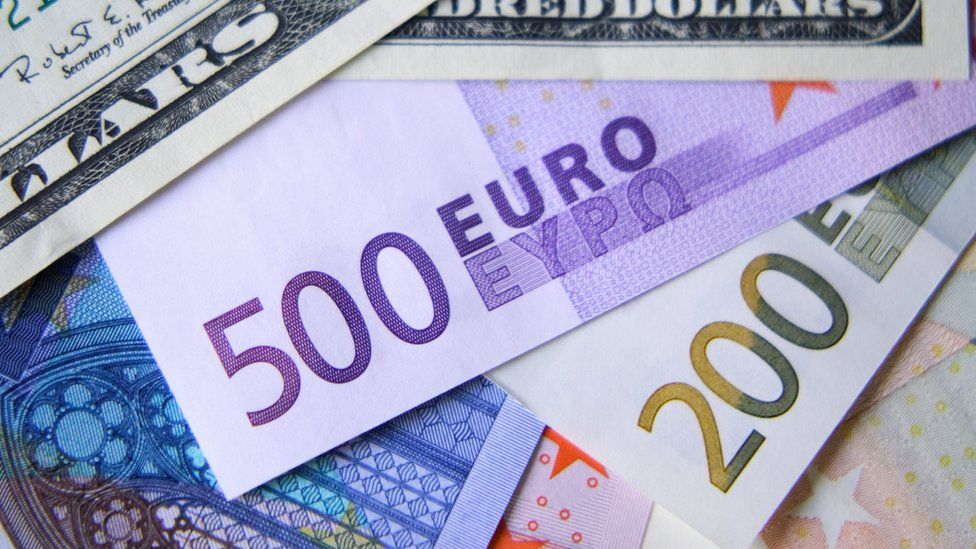The idea of a common currency in Europe can be traced back to the early 20th century, and since its inception in 1999, the Euro has become one of the most influential currencies in the global economy. As the world’s financial landscape evolves, the Euro faces new challenges and opportunities arising from the proliferation of Central Bank Digital Currencies (CBDCs), cryptocurrencies like Bitcoin, and the increasing influence of the BRICS nations. This blog post will delve into the history of the Euro, its impact on European supply chains, its importance in today’s world economy, and the future of the currency amidst these emerging trends and global financial dynamics.For a comprehensive understanding of the history of the US Dollar, you can refer to my other blog post where I take a deep dive into its background and significance.
Section I will provide an overview of the Euro’s history, from its early conceptualizations to the Maastricht Treaty, which paved the way for its official introduction in 1999. We will examine the benefits the Euro has brought to participating countries and the European Union (EU) as a whole, as well as the challenges it has faced, most notably the European sovereign debt crisis.
Section II will discuss the impact of the Euro on European supply chains, exploring how the common currency has facilitated cross-border trade, promoted price transparency, and fostered supply chain integration across the Eurozone. We will also consider the challenges that remain in light of the currency’s stability and the potential consequences of ongoing political and economic developments.
In Section III, we will assess the importance of the Euro in today’s world economy, examining its role in trade, financial markets, and as a reserve currency. This section will also discuss the challenges the Euro faces, such as economic disparities among Eurozone countries and political uncertainties.
Finally, Section IV will explore the future of the Euro amidst the rise of CBDCs, cryptocurrencies like Bitcoin, and the growing influence of the BRICS nations. We will consider the actions necessary for the Euro to maintain its role as a pillar of stability and growth in the face of these emerging trends and global financial dynamics.
A three-stage strategy for achieving Economic and Monetary Union (EMU) inside the EEC was laid forth in the Werner Report of 1970. In accordance with the idea, economic policies would be coordinated, exchange rates would be set, and eventually an unified currency would be implemented. Even if the strategy wasn’t entirely carried out at the time, it set the stage for subsequent initiatives.
The 1992 signing of the Maastricht Treaty marked a turning point in the economic integration of Europe. It established clear requirements for member nations, including steady currency exchange rates, low inflation, and prudent fiscal policies. The “convergence criteria” were created to guarantee that nations adopting the Euro would have robust, stable economies. The European Central Bank (ECB) and the European System of Central Banks (ESCB) were also established by the treaty to regulate the monetary policy of the Eurozone.
On January 1, 1999, the Euro was formally introduced as an electronic currency, with the initial participation of 11 EU nations. Austria, Belgium, Finland, France, Germany, Ireland, Italy, Luxembourg, the Netherlands, Portugal, and Spain comprised the group of nations collectively referred to as the Eurozone. In 2001, Greece became a member, and a number of other nations have since done the same.
On January 1, 2002, banknotes and coins were released, and the participating nations’ native currencies were gradually phased out. Today, 19 EU nations use the Euro as their official currency, and more than 340 million people worldwide use it.
The economies of the member nations and the EU as a whole have been significantly impacted by the Euro. By removing currency rate swings and lowering transaction costs, it has facilitated trade. The introduction of the unified currency has also boosted investment prospects, price transparency, and economic stability.
Despite all of its advantages, the Euro has encountered several difficulties, most notably the European sovereign debt crisis from 2009 to 2012. The crisis highlighted the weaknesses of some Eurozone nations, including Ireland, Greece, and Portugal, and it put the stability of the euro at risk. In response, European leaders developed the European Stability Mechanism (ESM), a banking union, and more stricter fiscal regulations like the European Fiscal Compact in order to guarantee financial stability inside the Eurozone.
European supply networks were defined by the difficulties and expenses of managing various currencies prior to the adoption of the Euro. For enterprises operating within the EU, exchange rate fluctuations, processing fees, and increasing administrative hurdles made cross-border commerce and procurement more difficult. Due to the lack of pricing transparency brought on by currency exchange rates, both providers and purchasers had difficulty making decisions, which could result in inefficiencies and resource misallocations.
The way firms in the Eurozone handle their supply chains has been significantly impacted by the adoption of the Euro. One of the most noticeable modifications is the ease with which cross-border trade can now be conducted, since there is no longer any requirement for currency translation and there are fewer dangers related to exchange rate swings thanks to the single currency. Because of the decreased transaction costs brought on by this simplification, purchasing materials and components from other Eurozone nations is now more affordable for enterprises.
The Euro has also fostered pricing transparency, making it simpler for firms to compare costs of goods and services across national borders. The increased competition among suppliers as a result of this increased transparency may result in lower prices and higher quality. Businesses have been able to select the most effective and economical suppliers as a result, optimizing their supply chain decisions.
Moreover, the promotion of supply chain integration across the Eurozone has benefited greatly from the Euro. The construction of more connected and effective supply chains has been facilitated by the common currency, which has pushed firms to establish more cooperative connections with their consumers and suppliers in other member states. By this integration, firms have been able to benefit from economies of size and scope, which can save costs, increase responsiveness, and improve supply chain performance as a whole.
The Euro has assisted in standardizing corporate procedures and laws inside the Eurozone in addition to strengthening cross-border ties. By standardizing these procedures, supply chain operations have become even more efficient overall, with fewer administrative hassles.
Notwithstanding the many advantages the Euro has for supply networks, difficulties nevertheless exist. Economic crises, like the European sovereign debt crisis, which can have repercussions on supply chains throughout the continent, have put the currency’s durability to the test. The future of the Euro and its impact on supply chains may also be impacted by continuing political and economic changes, such as Brexit and the emergence of nationalist forces in some member states.
Since its introduction in 1999, the Euro, the shared currency of the 19 countries that make up the European Union (EU), has become one of the most significant financial instruments in the world. The Euro has become a major player in global markets thanks to the Eurozone’s strong economic performance and significant trade relations. In this essay, the significance of the Euro is examined, with particular attention paid to its function as a reserve currency, in trade, and on the financial markets, as well as the difficulties it encounters.
A digital version of fiat money issued by central banks, CBDCs have the potential to improve financial transactions’ efficiency, transparency, and security. In order to supplement its current currency, the European Central Bank (ECB) has been actively investigating the creation of a digital Euro. The Euro’s usability, transaction costs, and competitiveness in the international financial system could all be improved by being digital.
The widespread use of CBDCs, nevertheless, would also put the Euro’s hegemony on the world market in jeopardy. The competitive environment may change as other central banks create and deploy their digital currencies, and the Euro will need to adapt and innovate to keep its significance.
II. The Rise of Bitcoin and Other Cryptocurrencies
A growing number of people are interested in using cryptocurrencies like Bitcoin as alternative payment methods and value stores. Users and investors from all over the world have been drawn to them due to their decentralized nature, possibility for anonymity, and capacity to avoid conventional financial intermediaries.
The emergence of cryptocurrencies both opportunities and difficulties for the Euro. On the one hand, cryptocurrencies could make the Euro less useful as more people turn to alternative payment methods. On the other hand, if the ECB is successful in introducing a digital Euro that blends the stability of the conventional currency with the benefits of digital technology, the Euro may profit from the rise in interest in digital assets.
3. The Development of the BRICS Countries
Brazil, Russia, India, China, and South Africa collectively known as BRICS, are a group of developing nations that have seen significant economic expansion and rising importance on the international scene. As the BRICS countries attempt to diversify their foreign exchange reserves and lessen their reliance on the US dollar and the Euro, the emergence of these countries could challenge the dominance of established currencies like the Euro.
The Euro must continue to support economic stability, develop trade ties with the BRICS countries, and adjust to the changing nature of the global economy if it is to remain relevant.
IV. The Future of the Euro in the Face of Changing Global Financial Trends
The Euro’s ability to negotiate the potential and risks given by CBDCs, cryptocurrencies like Bitcoin, and the emergence of the BRICS countries will determine how the currency will develop in the future. The Euro must: in order to continue serving as a bedrock of stability and expansion;
Embrace digital innovations: The ECB must create a digital euro that combines the advantages of digital currencies with the reliability and security of the existing euro.
Boost trade relations internationally: To strengthen the Euro’s position in international trade, the Eurozone should promote closer economic relations with the BRICS countries and other rising economies.
Support economic stability: With responsible fiscal and monetary policies, the Eurozone must address internal economic inequalities and maintain the stability of its currency.
With a GDP of more than $15 trillion as of 2021, the EU is one of the economies with the highest combined size in the world. As a result, the Euro is essential to global commerce. The EU is a significant trading partner for many nations, and the Euro has facilitated commerce by streamlining transactions and lowering currency risks between the Eurozone and the rest of the globe. Also, the common currency has improved price transparency, promoting European businesses’ ability to compete internationally and drawing in new investors. As a result, the Euro has established itself as a crucial means of trade in the world economy.
Beyond trade, the Euro is widely used in the world of financial markets. With its sophisticated and diverse capital markets, the Eurozone has emerged as a magnet for international investors. For instance, the market for bonds denominated in euros is one of the biggest and most liquid in the world, offering both domestic and international investors a wide range of investment opportunities.
The Euro also affects international interest rates and currency rates since the European Central Bank’s (ECB) monetary policy actions frequently have repercussions on other economies. The value of the Euro and its impact on other currencies can have an impact on global financial markets and trends as the ECB sets interest rates and undertakes quantitative easing initiatives.
Second only to the US dollar in terms of importance as a reserve currency is the Euro. As part of their foreign exchange reserves, central banks and governments all over the world hold assets denominated in the euro, which helps to diversify their portfolios and lower risk. The Euro’s function as a reserve currency, which offers a substitute for the US dollar and helps balance the power dynamics among major currencies, has also contributed to the stability of the global financial system.
The Euro confronts a number of difficulties despite its significance to the world economy. The endurance of the currency has been put to the test by economic inequality among Eurozone nations, the crisis of European sovereign debt, and persistent political uncertainties like Brexit. The stability and viability of the Euro are dependent on the EU member states’ capacity to resolve these problems and sustain a solid economic and political unity.
In conclusion, the Euro has played a transformative role in the European and global economy since its introduction in 1999. By facilitating trade, streamlining supply chains, and fostering economic stability, the Euro has become a cornerstone of the European project and a key player in the global financial system. However, the future of the currency will be shaped by its ability to navigate the challenges and opportunities presented by emerging trends such as CBDCs, cryptocurrencies like Bitcoin, and the rise of the BRICS nations. To maintain its position as a pillar of stability and growth, the Euro must embrace digital innovations, strengthen international trade relationships, and promote economic stability within the Eurozone. By addressing these challenges head-on, the Euro can solidify its role in the world economy and continue to contribute to the prosperity and cohesion of the European Union.






